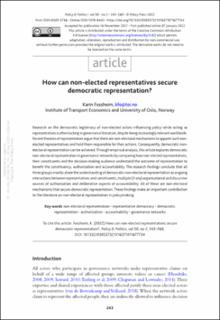| dc.contributor.author | Fossheim, Karin | |
| dc.coverage.spatial | Norway, Oslo | en_US |
| dc.date.accessioned | 2022-10-26T10:19:50Z | |
| dc.date.available | 2022-10-26T10:19:50Z | |
| dc.date.created | 2022-01-19T09:45:04Z | |
| dc.date.issued | 2022-01-07 | |
| dc.identifier.citation | Policy & Politics. 2022, 1-18. | en_US |
| dc.identifier.issn | 0305-5736 | |
| dc.identifier.uri | https://hdl.handle.net/11250/3028383 | |
| dc.description.abstract | Research on the democratic legitimacy of non-elected actors influencing policy while acting as representatives is often lacking in governance literature, despite being increasingly relevant worldwide. Recent theories of representation argue that there are non-electoral mechanisms to appoint such non-elected representatives and hold them responsible for their actions. Consequently, democratic non-electoral representation can be achieved. Through empirical analysis, this article explores democratic non-electoral representation in governance networks by comparing how non-elected representatives, their constituents and the decision-making audience understand the outcome of representation to benefit the constituency, authorisation and accountability. The research findings conclude that all three groups mostly share the understanding of democratic non-electoral representation as ongoing interactions between representatives and constituents, multiple (if any) organisational and discursive sources of authorisation and deliberative aspects of accountability. All of these are non-electoral mechanisms that secure democratic representation. These findings make an important contribution to the literature on non-electoral representation in policymaking. | en_US |
| dc.language.iso | eng | en_US |
| dc.publisher | Policy Press | en_US |
| dc.rights | Navngivelse 4.0 Internasjonal (CC BY 4.0) | |
| dc.rights.uri | http://creativecommons.org/licenses/by/4.0/deed.no | |
| dc.title | How can non-elected representatives secure democratic representation? | en_US |
| dc.type | Journal article | en_US |
| dc.type | Peer reviewed | en_US |
| dc.rights.holder | © Policy Press 2022 | en_US |
| dc.description.version | publishedVersion | en_US |
| cristin.ispublished | true | |
| cristin.fulltext | original | |
| cristin.qualitycode | 1 | |
| dc.identifier.doi | 10.1332/030557321X16371011677734 | |
| dc.identifier.cristin | 1984330 | |
| dc.source.journal | Policy & Politics | en_US |
| dc.source.volume | 50 | en_US |
| dc.source.issue | 2 | en_US |
| dc.source.pagenumber | 243-260 | en_US |
| dc.relation.project | Norges forskningsråd: 283332 | en_US |

